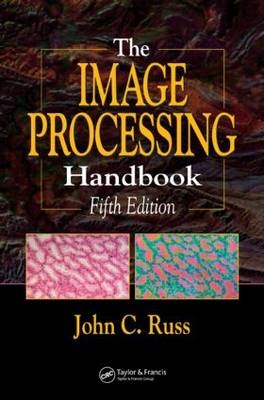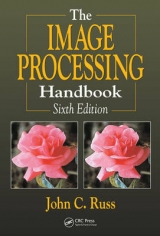
The Image Processing Handbook, Fifth Edition
Crc Press Inc (Verlag)
978-0-8493-7254-4 (ISBN)
- Titel erscheint in neuer Auflage
- Artikel merken
Now in its fifth edition, John C. Russ’s monumental image processing reference is an even more complete, modern, and hands-on tool than ever before. The Image Processing Handbook, Fifth Edition is fully updated and expanded to reflect the latest developments in the field. Written by an expert with unequalled experience and authority, it offers clear guidance on how to create, select, and use the most appropriate algorithms for a specific application.
What’s new in the Fifth Edition?
· A new chapter on the human visual process that explains which visual cues elicit a response from the viewer
· Description of the latest hardware and software for image acquisition and printing, reflecting the proliferation of the digital camera
· New material on multichannel images, including a major section on principal components analysis
· Expanded sections on deconvolution, extended dynamic range images, and image enlargement and interpolation
· More than 600 new and revised figures and illustrations for a total of more than 2000 illustrations
· 20% more references to the most up-to-date literature
Written in a relaxed and reader-friendly style, The Image Processing Handbook, Fifth Edition guides you through the myriad tools available for image processing and helps you understand how to select and apply each one.
Acquiring Images
Human Reliance on Images for Information
Video Cameras
CCD Cameras
Camera Artifacts and Limitations
Color Cameras
Camera Resolution
CMOS Cameras
Focusing
Electronics and Bandwidth Limitations
Pixels
Gray-Scale Resolution
Noise
High-Depth Images
Color Imaging
Digital Camera Limitations
Color Spaces
Color Correction
Color Displays
Image Types
Range Imaging
Multiple Images
Stereoscopy
Imaging Requirements
Human Vision
What We See and Why
Recognition
Technical Specs
Acuity
What the Eye Tells the Brain
Spatial Comparisons
Local to Global Hierarchies
It’s About Time
The Third Dimension
How versus What
Seeing What Isn’t There, and Vice Versa
Image Compression
A World of Light
Size Matters
Shape (Whatever That Means)
Context
Arrangements Must be Made
Seeing is Believing
So, in Conclusion
Printing and Storage
Printing
Dots on Paper
Color Printing
Printing Hardware
Film Recorders
Other Presentation Tools
File Storage
Storage Media
Magnetic Recording
Databases for Images
Browsing and Thumbnails
Lossless Coding
Reduced Color Palettes
JPEG Compression
Wavelet Compression
Fractal Compression
Digital Movies
Correcting Image Defects
Contrast Expansion
Noisy Images
Neighborhood Averaging
Neighborhood Ranking
Other Neighborhood Noise-Reduction Methods
Defect Removal, Maximum Entropy, and Maximum Likelihood
Nonuniform Illumination
Fitting a Background Function
Rank Leveling
Color Images
Nonplanar Views
Computer Graphics
Geometrical Distortion
Alignment
Interpolation
Morphing
Image Enhancement (Processing in the Spatial Domain)
Contrast Manipulation
Histogram Equalization
Laplacian
Derivatives
Finding Edges
Rank Operations
Texture
Fractal Analysis
Implementation Notes
Image Math
Subtracting Images
Multiplication and Division
Principal Components Analysis
Other Image Combinations
Processing Images in Frequency Space
What Frequency Space is All About
The Fourier Transform
Fourier Transforms of Real Functions
Frequencies and Orientations
Preferred Orientation
Texture and Fractals
Isolating Periodic Noise
Selective Masks and Filters
Selection of Periodic Information
Convolution
Deconvolution
Noise and Weiner Deconvolution
Template Matching and Correlation
Autocorrelation
Segmentation and Thresholding
Thresholding
Automatic Settings
Multiband Images
Two-Dimensional Thresholds
Multiband Thresholding
Thresholding from Texture
Multiple Thresholding Criteria
Textural Orientation
Region Boundaries
Selective Histograms
Boundary Lines
Contours
Image Representation
Other Segmentation Methods
The General Classification Problem
Processing Binary Images
Boolean Operations
Combining Boolean Operations
Masks
From Pixels to Features
Boolean Logic with Features
Selecting Features by Location
Double Thresholding
Erosion and Dilation
Opening and Closing
Isotropy
Measurements Using Erosion and Dilation
Extension to Gray-Scale Images
Morphology Neighborhood Parameters
Examples of Use
Euclidian Distance Map
Watershed Segmentation
Ultimate Eroded Points
Skeletonization
Boundary Lines and Thickening
Combining Skeleton and EDM
Global Image Measurements
Global Measurements and Stereology
Surface Area
ASTM Grain Size
Multiple Types of Surfaces
Length
Sampling Strategies
Determining Number
Curvature, Connectivity, and the Disector
Anisotropy and Gradients
Size Distributions
Classical Stereology (Unfolding)
Feature-Specific Measurements
Brightness Measurements
Determining Location
Orientation
Neighbor Relationships
Alignment
Counting Features
Special Counting Procedures
Feature Size
Circles and Ellipses
Caliper Dimensions
Perimeter
Describing Shape
Fractal Dimension
Harmonic Analysis
Topology
Three-Dimensional Measurements
Feature Recognition and Classification
Template Matching and Cross-Section
Parametric Description
Decision Points
Multidimensional Classification
Learning Systems
kNN and Cluster Analysis
Expert Systems
Neural Networks
Syntactical Models
Tomographic Imaging
Volume Imaging vs. Sections
Basics of Reconstruction
Algebraic Reconstruction Methods
Maximum Entropy
Defects in Reconstructed Images
Beam Hardening
Imaging Geometries
Three-Dimensional Tomography
High-Resolution Tomography
3-D Image Visualization
Sources of 3-D Data
Serial Sections
Optical Sectioning
Sequential Removal
Stereo Measurement
3-D Data Sets
Slicing the Data Set
Arbitrary Section Planes
The Use of Color
Volumetric Display
Stereo Viewing
Special Display Hardware
Ray Tracing
Reflection
Surfaces
Multi-Ply Connected Surfaces
Image Processing in 3-D
Measurements on 3-D Images
Imaging Surfaces
Producing Surfaces
Devices that Image Surfaces by Physical Contact
Noncontacting Measurements
Microscopy of Surfaces
Surface Composition Imaging
Processing of Range Images
Processing of Composition Maps
Data Presentation and Visualization
Rendering and Visualization
Analysis of Surface Data
Profile Measurements
The Birmingham Measurement Suite
Topographic Analysis and Fractal Dimensions
References
Index
| Erscheint lt. Verlag | 19.12.2006 |
|---|---|
| Zusatzinfo | 1800 Halftones, black and white; 11 Tables, black and white; 2006 Illustrations, color; 2006 Illustrations, black and white |
| Verlagsort | Bosa Roca |
| Sprache | englisch |
| Maße | 178 x 254 mm |
| Gewicht | 1905 g |
| Themenwelt | Informatik ► Grafik / Design ► Digitale Bildverarbeitung |
| ISBN-10 | 0-8493-7254-2 / 0849372542 |
| ISBN-13 | 978-0-8493-7254-4 / 9780849372544 |
| Zustand | Neuware |
| Haben Sie eine Frage zum Produkt? |
aus dem Bereich



